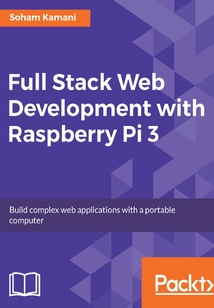目錄(154章)
倒序
- cover
- Title Page
- Copyright
- Full Stack Web Development with Raspberry Pi 3
- Credits
- About the Author
- About the Reviewers
- www.PacktPub.com
- Why subscribe?
- Customer Feedback
- Preface
- What this book covers
- What you need for this book
- Who this book is for
- Conventions
- Reader feedback
- Customer support
- Downloading the example code
- Downloading the color images of this book
- Errata
- Piracy
- Questions
- Getting Started on the Raspberry Pi
- The Internet of Things
- A brief look at our application
- The sensor interface - perception
- The database - persistence
- The user interface - presentation
- The application server - middleware
- Setting up our Raspberry Pi
- Remote access
- Summary
- Getting Up-and-Running with Web Development on the Raspberry Pi
- The network
- The web development stack
- The UI - the user's first encounter
- The server - the brains of the application
- Client-server communication
- Interfacing with external hardware
- The database - adding persistence to our data
- Integrating the database into our application
- The overall architecture
- Summary
- Running a Node Server on the Pi
- Introducing nodes - the server side JavaScript runtime
- Installing node on the Pi
- Running our first node program
- Setting up a version control system
- Back to our program
- Installing external libraries
- Developing the application server
- Adding routes to the server
- Starting up the server
- Keeping the server running in the background
- Summary
- Extracting Information from the GPIO Pins
- The GPIO pins on the Pi
- The pin as a standalone component
- The Write mode
- The Read mode
- Fine-tuning our control - using the GPIO command-line tools
- The DHT11 sensor
- Reading from the sensor
- Summary
- Retrieving Sensor Readings from the Server
- Understanding how our node process takes readings
- Modifying our server code to show sensor readings
- Optimizing our server
- Abstracting our sensor library code
- Caching our results
- Summary
- Creating a Web Page to Display Sensor Data
- Extending our application
- Serving static files from the Express server
- Building the UI's functionality
- Adding client-side JavaScript
- Fetching sensor readings using XHR
- Visually enhancing the UI
- Changing the structure of our UI
- Adding style to the newly modified structure
- Summary
- Enhancing Our UI - Using Interactive Charts
- Considerations when implementing complex features
- Introducing Chart.js
- Installing Chart.js
- Creating our first chart
- Making the server response data-friendly
- Modifying the sensor dashboards to consume JSON data
- Integrating sensor data into our charts
- A code overview
- index.js
- public/index.html
- public/script.js
- Summary
- SQLite - The Fast and Portable Database
- Picking the correct tool for the job
- Installation
- Creating the temperature and humidity tables
- Running CRUD operations
- Create
- Read
- Update
- Delete
- Aggregations
- Advanced aggregations using subqueries
- Summary
- Integrating SQLite into Our Application
- Getting started: Interfacing SQLite with node
- Running queries with node
- Making our database module
- Adding a new temperature to the database
- Fetching the last "n" readings from a table
- Fetching readings between a certain time period
- Fetching the average of readings between time periods
- Putting the functions together in a module
- Integrating the database module into our server application
- Upgrading the sensor interface module
- Adding an API to get the latest ten readings
- Consuming the API on the client side
- Adding new features - the ability to view readings from a custom time period
- Adding the required APIs
- Summary
- Making our Application Real Time with Web Sockets
- Web sockets
- Implementing web sockets in our application
- The socket.io library
- Client-side installation
- Server-side installation
- Creating our socket implementation in our application server
- Client-side implementation
- Summary
- Deploying our application to Firebase
- The Firebase platform
- Migrating to Firebase
- The User interface
- Database
- Server application and sensor interface
- Creating your first Firebase application
- Installing the Firebase CLI
- Logging in to Firebase on the command line
- Initializing a new Firebase application
- Testing and deploying the application to the cloud
- Migrating the frontend assets
- Adding Firebase tools
- Adding the Realtime Database
- Enabling access to the Firebase Database
- Adding listeners to the client-side script
- Summary
- Using Firebase APIs to Update Our Application
- Application server versus application process
- Securing our application
- The application process architecture
- Implementing the application process
- Summary 更新時間:2021-07-15 17:10:53
推薦閱讀
- The DevOps 2.3 Toolkit
- Apache Karaf Cookbook
- Responsive Web Design by Example
- 深入淺出PostgreSQL
- JavaCAPS基礎、應用與案例
- Python深度學習:模型、方法與實現
- 響應式架構:消息模式Actor實現與Scala、Akka應用集成
- BeagleBone Robotic Projects(Second Edition)
- Java Web應用開發項目教程
- OpenMP核心技術指南
- OpenCV with Python Blueprints
- Mockito Essentials
- Java 從入門到項目實踐(超值版)
- Simulation for Data Science with R
- .NET 4.0面向對象編程漫談:應用篇
- IPython Interactive Computing and Visualization Cookbook
- C# 7.0核心技術指南(原書第7版)
- MySQL 5.7從入門到精通(視頻教學版)(第2版)
- 零基礎學Visual Basic第2版
- Python商業數據分析:零售和電子商務案例詳解(雙色)
- Instant Pentaho Data Integration Kitchen
- 從Scratch進階到Python(基礎篇)
- Introducing Microsoft SQL Server 2019
- Creative Projects for Rust Programmers
- Selenium 1.0 Testing Tools: Beginner's Guide
- Visual Basic程序設計實驗指導
- Visual Basic編程全能詞典
- Programming the BeagleBone
- Web Development with Django Cookbook(Second Edition)
- TypeScript+Vue.js前端開發從入門到精通


